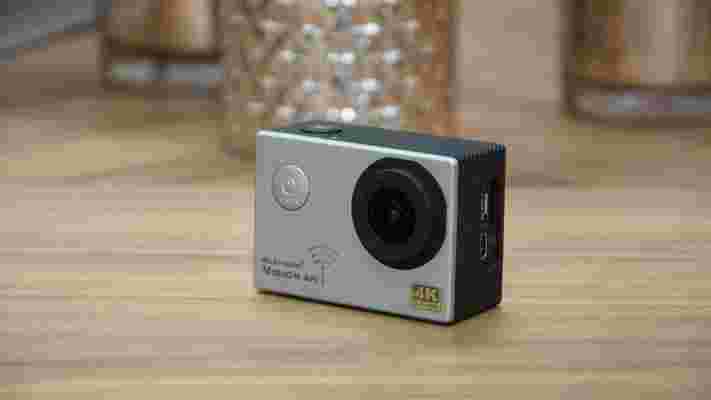Before GoPro, action cameras existed but nobody cared; now, everyone wants to get their hands on a camera to film their adventures. The problem? Not everyone can justify spending hundreds of pounds to do so. Step forward the GoXtreme Vision 4K: an action camera that records in high-resolution 4K, but doesn’t cost the earth.
READ NEXT: Yi 4K+ review: A GoPro Hero6 action camera rival
GoXtreme Vision 4K review: What you need to know
The GoXtreme Vision 4K doesn’t shoot native 4K footage, though. In fact, its 12-megapixel sensor records at 2,880 x 2,160 and delivers 4K footage at 24fps through interpolation. Beyond that, though, it’s pretty standard action camera fare.
The GoXtreme is lightweight, rugged and pocketable, comes with a fixed 170-degree wide angle lens and a 2in screen on the rear. There’s a large set of accessories included in the box to help you attach the camera about your person or to objects. Plus you also get a waterproof case that allows you to submerge the camera to a depth of 30m.
The GoXtreme is every bit the GoPro copycat. The question is, can it match GoPro in terms of usability and quality?
READ NEXT: Best action cameras for 4K recording, running, cycling and more
GoXtreme Vision 4K review: Price and competition
It would be great if it could because the price is very attractive. At £100, the GoXtreme Vision 4K is considerably cheaper than the lowest-cost current GoPro. Having said that, you can buy even cheaper 4K-ish action cameras than the GoXtreme, all of which offer a similar package of specifications and features.

For around £70 there’s the Akaso EK7000 and Apeman 4K and if you want an ultra-budget 4K action camera there’s the Yi Discovery Action Camera 4K at £43 which outdoes the GoXtreme in at least one way – it has a touchscreen.



GoXtreme Vision 4K review: Design and features
The GoXtreme Vision 4K is near-identical in size and shape to the GoPro Hero 3 and 4. It measures 59 x 41 x 29mm – about the size of a matchbox and the buttons are in similar places as well.
At the front next to the protruding wide-angle lens sits the power button and a blue-and-red LED that indicates when the camera is recording and broadcasting a Wi-Fi signal. At the top is a yellow status LED and the GoXtreme’s recording button.
On the left of the camera is a mini-HDMI and a microUSB port, plus a microSD slot that takes cards up to 64GB in capacity. At the bottom is a latched flap that gives access to a 1,050mAh removable battery and the right side houses two buttons used for navigation.
The camera also has a 2in LCD display on the rear which lets you preview your footage, a tripod thread on the base and the whole thing squeezes into a transparent waterproof case that allows it to be submerged to a depth of up to 30m.
The lack of a touchscreen means change settings on the device is a bit fiddly but you can circumvent that by using the accompanying OKCAM app (available for both Android and iOS devices ). This lets you tweak things more easily on the screen of your smartphone and also offers a live preview.
So far, so familiar. Where the GoXtreme Vision 4K misses out is that it doesn’t have GPS, so you won’t be able to overlay positional and speed data on top of your clips once captured.
READ NEXT: GoPro Hero 5 Session review: Size doesn’t matter
GoXtreme Vision 4K review: Image, video and audio quality
The question here is its performance. Can a sub-£100 “4K” action camera truly compete with the likes of the GoPro Hero5, Hero6 and the Yi 4K/4K+? The short answer is no.
First, as mentioned above, the camera doesn’t record true 4K (3,840 x 2,160). In fact, the native output resolution is 2,880 x 2,160 with interpolation applied. In other words, the sensor is only capable of capturing so many pixels
The result, compared with cameras recording in native 4K, is less detail. Check out the snapshots below, which are taken from the GoXtreme Vision 4K at 4K, 24fps and the Yi 4K+ at 24fps.
^ GoXtreme Vision 4K at 4K 24fps – 300% crop
^ Yi 4K+ at 4K 24fps – 300% crop
You can see there’s detail missing around the railings in the foreground and background, while the trees suffer from considerably image noise and lack definition. You get what you pay for, in other words.
With the resolution dialled down to Full HD (1,920 x 1,080), the GoXtreme Vision 4K stacks up against the Yi 4K+ a lot better. As for the colour reproduction, the GoXtreme Vision 4K doesn’t wash out or over saturate them in stills or video recordings.
Speaking of stills, the camera’s 12-megapixel sensor also uses interpolation to upscale images, this time to a resolution of 16 megapixels (4,608 x 3,456). The results are surprisingly decent.
The GoXtreme Vision 4K captures plenty of detail and even colour reproduction throughout the image. There is minor image noise when cropped in at around 300%, but in comparison to a far more expensive camera, the difference is negligible.
^ GoXtreme Vision 4K still
^ Yi 4K+ still
It’s also worth mentioning that the camera has HDR, which I left enabled throughout my tests. With it disabled, colours are a tad less punchy.
READ NEXT: GoPro Hero 5 Black review: Now free if you bought a Karma
GoXtreme Vision 4K review: Verdict
The GoXtreme Vision 4K isn’t the only sub-£100 pseudo-action camera. In fact, there are many to choose from and in this case, if I was hard-pressed to make a recommendation, I’d pick the Apeman 4K , Akaso EK7000 or the Yi Discovery Action Camera 4K . That’s not because the GoXtreme is particularly bad but because you’ll save yourself a few quid if you do.
In fact, with the camera not really recording true 4K anyway, you might as well just cut your losses and opt for a pure 1080p camera such as the Yi HD Sport Camera and Apeman equivalent instead.











